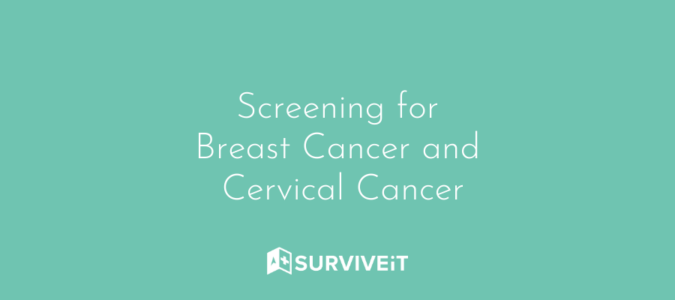The Importance of Screening | Women’s Health Month

May is women’s health month, so we thought we’d focus on the measures women can take to routinely screen for two cancers that commonly affect women.
When it comes to cancer, early detection is important, that’s why we want to put a large emphasis on screening. Women who take measures to screen themselves for certain types of cancers have a better chance of early detection when no symptoms are present.
Let’s take a closer look at breast cancer and cervical cancer and the types of screenings available for women.
Screening for Breast Cancer
The American Cancer Society estimates that about 276,480 new cases of invasive breast cancer will be diagnosed in women in 2020 in the U.S., and about 48,530 new cases of carcinoma will be diagnosed.
Breast Cancer Screening By Age
- Women ages 40 to 44 should have the choice to start annual breast cancer screening with mammograms (x-rays of the breast) if they wish to do so.
- Women age 45 to 54 should get mammograms every year.
- Women 55 and older should switch to mammograms every 2 years, or can continue yearly screening.
- Screening should continue as long as a woman is in good health and is expected to live 10 more years or longer.
(American Cancer Society)
Breast Examinations
Breast examinations can be conducted both by a healthcare professional as well as by women. You can make a breast examination part of your health routine by learning the steps involved. This guide provides 5 steps as well as visual instructions to help you.
If at any point, you find a lump or are concerned, consult with your doctor.
Mammograms
Mammograms, which take X-ray pictures of the breast, can help detect breast cancer early on.
“You will stand in front of a special X-ray machine. A technologist will place your breast on a clear plastic plate. Another plate will firmly press your breast from above. The plates will flatten the breast, holding it still while the X-ray is being taken. You will feel some pressure. The steps are repeated to make a side view of the breast. The other breast will be X-rayed in the same way. You will then wait while the technologist checks the four X-rays to make sure the pictures do not need to be re-done. Keep in mind that the technologist cannot tell you the results of your mammogram. Each woman’s mammogram may look a little different because all breasts are a little different.”
Breast MRI
A Breast MRI is often used, along with mammograms, to screen women who are at higher risk of getting breast cancer. Using magnet and radio waves, and MRI takes pictures of the breast.
Screening for Cervical Cancer
The American Cancer Society predicts that about 13,800 women will be diagnosed with invasive cervical cancer in 2020 in the United States. More common than the invasive cervical cancer diagnosis is cervical pre-cancer diagnosis.
At one point, cervical cancer was one of the most common causes of death for women in America, but with the increased use of the Pap test, death rates have significantly declined. This is why it’s so important for women to get regular Pap Smears.
Cervical Cancer Screening By Age
- All women should begin cervical cancer testing (screening) at age 21.
- Women aged 21 to 29, should have a Pap test every 3 years. HPV testing should not be used for screening in this age group unless it is needed as after an abnormal Pap test result.
- Beginning at age 30, women should be screened with a Pap test combined with an HPV test every 5 years as long as the test results are normal. This is called co-testing and should continue until age 65.
(American Cancer Society)
Pap Smear
As we already stated, the Pap Smear, or Pap Test, has played a large role in early detection of cervical cancer and reducing the number of women who die from cervical cancer.
“The Pap test, also called the Pap smear, is a cervical cancer screening test. It is not used to detect other kinds of cancer. It is done in a doctor’s office or a clinic. This test can find abnormal cells in the cervix that may turn into cancer if they’re not treated.
During the test, the doctor or nurse uses a plastic or metal instrument, called a speculum, to widen the vagina. This helps the doctor or nurse examine the vagina and the cervix, and collect a few cells and mucus from the cervix and the area around it. These cells are placed on a slide and sent to a laboratory to be checked for abnormal cells.”
If you are over the age of 21 and have not had a Pap test, speak with your doctor.
The HPV Test
The HPV test screens women for the human papillomavirus which can cause cells to change and become precancerous.
Breast Cancer and Cervical Cancer Resources
If you’re unsure if you’ve been screened or have questions about your health, consult your doctor. You can always advocate for your own health by doing research and asking questions.
For more information, or if you or a loved one has recently been diagnosed with either breast cancer or cervical cancer, visit our resource library.
Breast Cancer Resource Library | Cervical Cancer Resource Library
